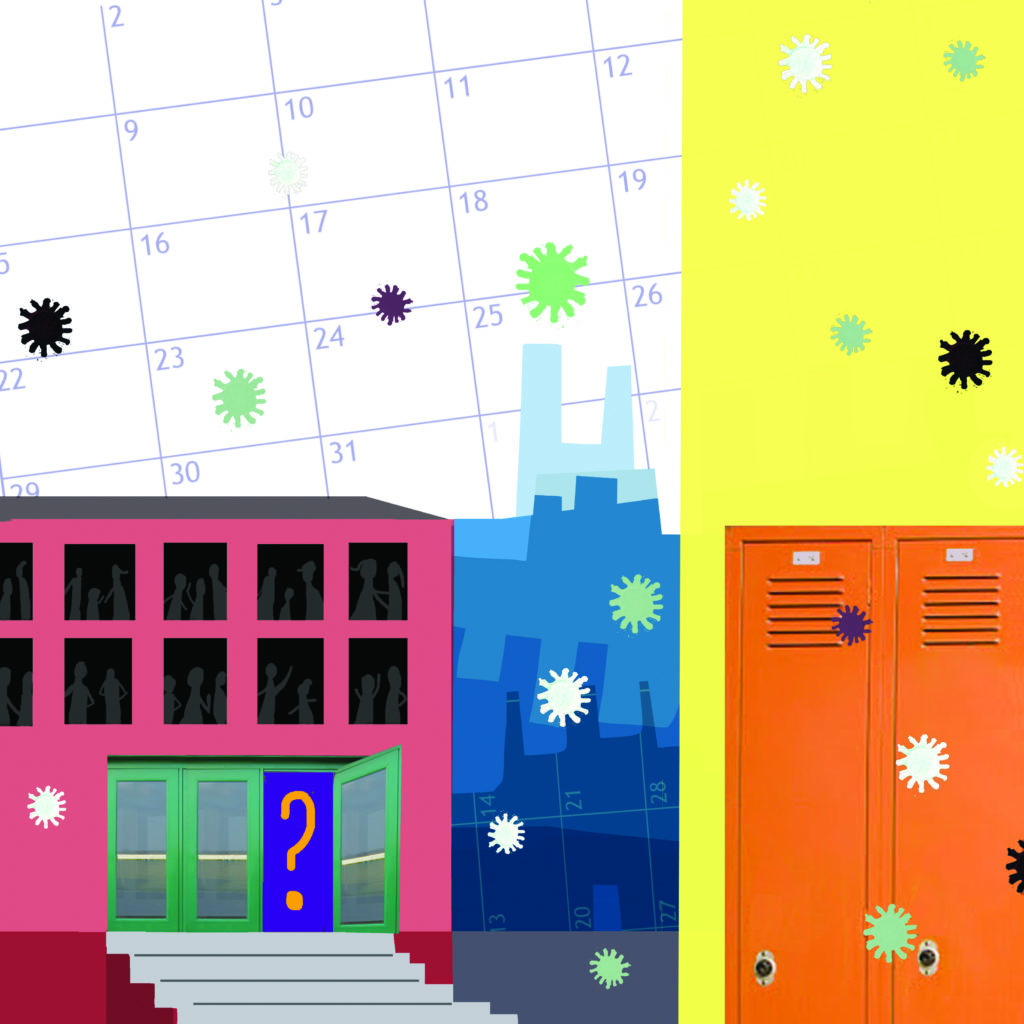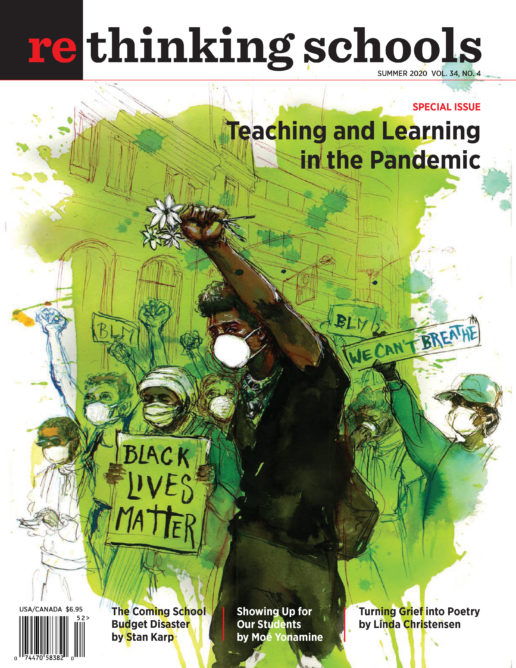Coronavirus, Sick-Outs, and the Fight to Close New York City Schools
Illustrator: Katherine Streeter

New York City has become the epicenter of the coronavirus pandemic, and its public schools, which serve 1.1 million students and employ nearly 135,000 people, officially closed on March 17. But this was much too late — and it’s only because of rank-and-file organizing that they even closed when they did.
In the weeks and days before the schools closed, teachers, paraprofessionals, service providers, office staff, administrators, cafeteria workers, nurses, bus drivers, school safety agents, parent coordinators, students, and all of their family members unnecessarily exposed themselves to the virus. Each day, we were forced to crowd the public transit system and public schools as uncertainty and danger mounted around us.
And the cost has been devastating. As of early June, the death toll in New York City reached more than 17,000. Among them are dozens of educators including paraprofessionals, teachers, administrators, facilities staffers, school aides, food service workers, guidance counselors, central office employees, at least one parent coordinator, and at least one computer technology specialist, according to WABC-TV. The hardest hit group has been paraprofessionals, who are predominantly Black and Latinx and earn significantly less than teachers. According to an April 20 report from WABC-TV, paraprofessionals accounted for 40 percent of confirmed cases despite representing only 17 percent of the New York City public school workforce.
Different versions of this moment, and how and why the schools closed, will be told years from now. It’s vital that this history is told from the perspective of those of us who organized to shut the schools down with the threat of sick-outs, something that was rarely mentioned in the mainstream media.
Different versions of this moment, and how and why the schools closed, will be told years from now. It’s vital that this history is told from the perspective of those of us who organized to shut the schools down with the threat of sick-outs, something that was rarely mentioned in the mainstream media.
The first publicized cases of COVID-19 in New York were in February and early March, and included a New York City public school teacher who had visited Italy; the teacher self-reported after spending a full week with her students. As cases began mounting and the threat to schools became evident, Mayor Bill de Blasio remained obstinate that schools would remain open instead of taking immediate measures to respond to safety concerns. New York City Schools Chancellor Richard Carranza also stated that there wasn’t sufficient evidence that any schoolchildren exhibited symptoms and the administration downplayed any call for serious preparation to shut down.
Meanwhile, as instructed by city and state policy, several teachers who tested positive for coronavirus were self-reporting to their administrations. Yet, when administrators did their due diligence by reporting these cases to central administration, they were instructed to not report the cases to the Department of Health.
“At the moment, there is no reason for any school to call [the Health Department] to report potential or confirmed cases,” Carranza wrote in an email to administrators on March 10 that was obtained by the New York Post. He went on to write that the “DOH would get test results from labs, and school personnel should help ‘by keeping their phones clear,’” according to the Post.
“At the moment, there is no reason for any school to call [the Health Department] to report potential or confirmed cases.”
Chancellor Richard Carranza
The United Federation of Teachers (UFT) leadership responded by threatening a lawsuit. The union’s president, Michael Mulgrew, said that the union and the mayor would “agree to disagree” around the decision to keep the schools open until further notice.
Meanwhile, silenced teachers made a desperate plan to organize mass sick-outs through the Movement of Rank and File Educators, a caucus within the UFT. By March 9, several teachers had reached out asking for support in forcing the city to close their schools.
While both the mayor and the governor declared states of emergency, and gatherings of more than 500 people were banned in the state, public schools remained a glaring exception. The number of confirmed cases was increasing exponentially each day. Predictions of the toll the pandemic would take on the city’s healthcare system were alarming. Scientists released public letters stressing the importance of school closures in containing the pandemic. Indeed, several districts in New York, along with charter and private schools in the city, were already closing. Yet Mayor de Blasio, invoking a sort of “New York City exceptionalism,” continued to insist that schools needed to remain open.
Many teachers were alarmed by what they saw as the mayor’s disregard for their well-being. A Department of Education policy required a building with a confirmed case to close for a day of deep cleaning — a strategy to contain the pandemic that has not been supported by scientific evidence. In some cases, the DOE failed to follow its own guidelines, refusing to close a school if a case confirmation came from the wrong agency. Many other DOE actions fueled the desperation of teachers. At the Grace Dodge campus in the Bronx, teachers reported being told by supervisors that they could be fired if they recommended students stay home to avoid exposure. At Brooklyn Technical High School, teachers accused the DOE of covering up cases and failing to communicate them to the school community.
In the days before the mayor’s hand was forced, talks of a sick-out spread. Enough teachers were talking that buzz was generated.
“Teachers plan for ‘mass sick-out’ as calls for school closures escalate,” read the headline to a March 14 article on silive.com.
“With Mayor Bill de Blasio holding firm on his decision not to close New York City public schools next week, some teachers are taking matters into their own hands in an attempt to sway his decision making,” the article read. “City teachers are planning a ‘mass sickout’ . . . where droves of employees will call out sick to show their disapproval of the mayor’s decision, multiple teachers told the Advance.”
“Some teachers are taking matters into their own hands in an attempt to sway his decision making.”
March 14 article on silive.com
Several had planned to call out Monday — and longer, if need be. It’s true that for some their main concern was their health and that of their family. But for many, calling out was a strategy to signal to the DOE that its workers will not work in an unsafe environment. This idea was made more persuasive by two developments: the UFT’s, albeit belatedly, recommendation that the schools close, as well as the dramatic decline in student attendance that Friday. So the call for a sick-out struck a chord and clearly electrified a section of educators. More than 400 of those educators — including rank-and-file leaders — participated in an organizing call over Zoom that Saturday, March 14.
“Public schools: Close to 60 percent or even 70 percent of teachers are calling in that they will be out in every school, so there won’t be much teaching to do. Less than half of the students are likely to show up. Can we arrive at a plan to close and to care for students who cannot go home?” Gale A. Brewer, Manhattan borough president, tweeted on Sunday, March 15.
That same weekend, “UFT officials told union representatives . . . to ‘advise against’ a planned call out,” according to the New York Daily News.
“‘A coordinated sick-out will be interpreted by the DOE as an organized effort in violation of the Taylor Law and the Triborough Law,’ union officials wrote its district representatives,” the article read. “‘They will perceive it as a labor action and strike. . . . Please advise against.’”
Gracie Mansion, too, seemed to have gotten word that teacher attendance would drop significantly, for the mayor soon made the announcement to close schools.
Of course, several factors contributed to the mayor’s decision. But the variety of pressures from educators — including the sick-out — clearly pushed the mayor to make a decision he hoped to delay, as evidenced by the absence of a plan to transition to remote learning. In fact, staff were expected to report to their schools that following Tuesday through Thursday to wait for remote learning directives with the advice to simply practice social distancing. This increased the likelihood of several NYC DOE staff members being exposed to the virus. This lack of planning is striking considering that news of a coming pandemic was known in the United States at least two months prior to NYC schools closing. Throughout that time the DOE could have researched software, trained personnel, and delivered devices to the 300,000 students who were in need. The absence of the plan especially contradicts the mayor’s initial reasons for keeping school open — “concern for the students” — considering that those disproportionately hurt by this improvised transition are the students most in need. Regardless of the reasons he gave, the mayor’s commitment to keeping schools open had less to do with the well-being of children than with his priority in keeping the economy going in spite of a pandemic.
After this pandemic is over, history will show how politicians — from Trump down to de Blasio — failed to reduce the outbreak by delaying appropriate responses. But history will also show how their failures were mitigated, to whatever extent that may be, by ordinary workers. Perhaps history will also tell of how NYC teachers used the crisis to recreate a new, egalitarian school system. It’s clear that our ability to respond better to the next crisis depends on creating a new normal.
Subscribe to Rethinking Schools magazine at rethinkingschools.org/subscribe.

